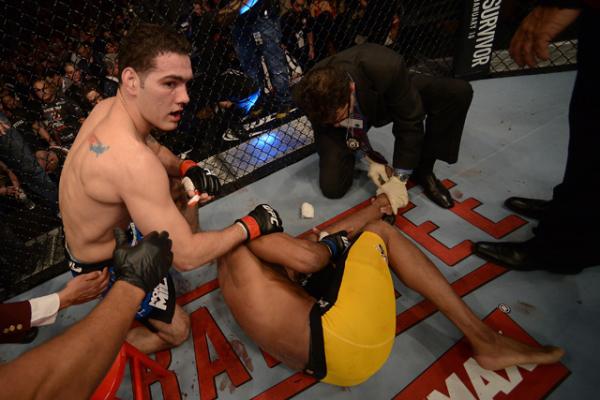Fight Medicine: A Broken Bone, Broken Champion

Anderson Silva went under the knife immediately following UFC
168. | Donald Miralle/Zuffa LLC/Getty Images
Last night witnessed the shocking end to one of the most anticipated rematches in UFC history.
Anderson Silva, considered one of the greatest fighters of all time, suffered a broken leg when defending champion Chris Weidman checked a low kick in the second round of their title bout at UFC 168 in Las Vegas.
Advertisement
Anderson suffered a fracture of both his tibia (shin bone) and fibula (the small bone in the leg that forms the outside of the ankle). This injury is not unknown to the sports world, as it has been witnessed in the virtually all mainstream sports.
An open fracture is when the bone breaks through the skin (also
called a compound fracture). When this happens, the natural barrier
between the outside world and the bone is disrupted and bacteria,
dirt, and even clothing can get caught inside the bone and provide
a place for an infection to develop.
Infections in the bone are bad players and often can hide from antibiotics and result in fractures not healing and further surgeries to remove dead bone. As a result, once a fracture is determined to be open, the clock starts and it becomes a race against time to clean the wound out in the sterile operating room to prevent infections from happening.
Sometimes the bone sticks out of the leg in grotesque fashion as in Kevin Ware’s case. Other times, it pokes out of the skin and then goes back inside, but leaves a hole in the skin which acts as evidence that it was an open fracture. The size of the hole and whether there is any significant skin damage will determine the chances of infection.
Other reasons to take a fracture urgently to the operating room include blood vessel damage, nerve injury, or significant enough swelling that the blood flow to the leg becomes compromised (called compartment syndrome). It doesn’t look like any of these were the case with Anderson Silva, but they are always on the mind of the doctor.
When an injury like this occurs, the paramedics or ringside doctor will splint the broken leg, as what is most painful to the athlete is when the leg moves and the two separate pieces move freely. Sometimes the bone fragments can be sharp enough to cut nerves, blood vessels, or even poke through the skin when it wasn’t open with the original injury.
Then, once the fracture is stabilized, the athlete is taken to the hospital for X-rays to determine the pattern of the fracture. Based on the pattern and the size of any skin defects, a plate and screws or a rod can be inserted to stabilize the fracture. In Silva’s case, a rod was placed from the knee down the leg to stabilize the tibia since bones are hollow and the rod helps line the bone back up. Then the rod is held in place by screws drilled from one side of the bone into the rod and out the other side of the bone.
Then, depending on the pattern of the fracture, the athlete can begin immediate weight-bearing or will need to stay off of it until there are signs of healing. After the surgery, in the case of an open fracture, the patient will need to stay in the hospital for at least 24 hours of intravenous antibiotics to further prevent infection.
Fractures such as these often heal, but there is a poor anatomic blood supply to this part of the tibia, so sometimes they take a long time to recover or don’t heal at all without further surgery. Once the fracture does heal, the question at six months to a year then becomes whether the athlete should have the screws or both the rod and screws taken out. The screws are just under the skin and can cause irritation or pain, especially in skinny people such as Silva, or when someone throws a kick.
If the rod and screws are taken out, Silva must undergo another surgery and then likely stay off the leg until the holes where the screws were once present fill in, as they can act as stress risers for a new fracture to occur.
Only time will tell if we will see Silva back in the Octagon he has ruled for so long. With this type of injury, it will be at least 6 months to one year and possibly longer before the 38-year old Brazilian can show why he is still, and always will be, considered one of the greatest UFC fighters of all time.
Jon Gelber is Sherdog.com’s resident “Fight Doctor.” Want your question answered by The Fight Doctor in the Fight Medicine Mailbag? You can contact him by email at [email protected] or follow him on Twitter @fightmedicine. You can also read more about MMA Injuries, Health, and Training at FightMedicine.net.
Related Articles






